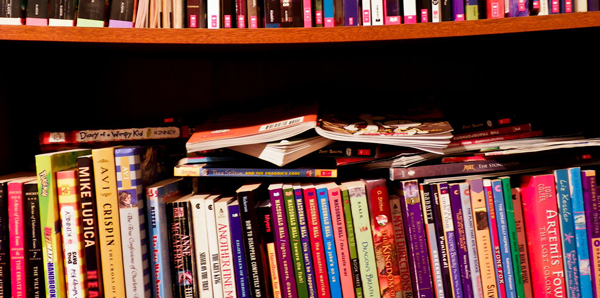Bugs That Eat Books!
By Chris Williams on March 21, 2013.

You’ve probably seen news reports about bed bugs infesting library books. The bed bugs come from books that have been in bed bug-infested homes. The bugs are simply hiding in the books as they would hide in any crack or crevice. There are, however, pests who actually feed on books. Some pests just graze on the surface starches or glues on papers and books. Others will actually bore into books and eat the paper, and some feed on mold that grows on the surface of damp paper products.
The Grazers
The most familiar paper pest is the silverfish. It likes starchy foods and will feed on glazed papers or on the starchy glue or paste in book bindings or wallpaper. Silverfish leave dull, de-glossed, light-colored areas on book covers or pages where they have removed the finish. They also sometimes notch the edges of pages and leave yellowish stains on paper from body scales and feces.
The large American cockroach (not the smaller German cockroach) will also feed on books and papers and leaves damage similar to that of silverfish. Both of these pests prefer papers that are soiled from body oils, food stains, or other insects. Books or papers that are stored in cardboard boxes in attics or basements are most likely to be infested.
The Borers
The larvae of several small, dark beetles will bore into books. Books are not their usual food; they feed on wood, or grain food products, or animal parts. But, since books are made up of cellulose paper, often with leather covers held together with animal or flour-based glue, they are full of edible parts for these larvae. Sometimes beetle larvae will bore into books simply looking for a protected place in which to pupate. When the adult beetles emerge, they leave tiny, round exit holes in the book.
Termites also enjoy a good book. After all, paper is just processed wood. Books are susceptible to termite attack when they are stacked on the floor or are undisturbed in a damp basement or storage area. Termites may enter the structure from a ground nest outside and tunnel directly into books or stored papers.
Mold Eaters
Booklice are not lice at all, but are small, white wingless insects that are found in very damp or humid situations where they feed on mold that grows on the surface of books, papers, and other items. There are also a number of small mold or fungus beetles that will feed on mold on books or papers, including wallpaper. These pests are feeding on mold, not on the paper itself, so they usually do little damage.
What Can You Do?
Spraying or dusting books with insecticides is not recommended since it is too easy to damage the books further. If the books or papers are not valuable, it is best to just discard them (along with any cardboard boxes). Insecticide area treatments of attics or storage areas can sometimes be effective for certain pests. Mold pests are easily controlled without insecticides by drying out the area with heat, fans or dehumidifiers, or by simply moving the books or papers to a drier site.
Libraries and museums have more sophisticated methods to treat books, but freezing is often used. Paper pests can be killed by freezing at -3 degrees F. for 3-4 days. Papers should be sealed in plastic first, and slowly thawed (still in plastic) after freezing. Microwaving or heating books or papers is not recommended.
Photo credit: Sharon Drummond / Foter.com / CC BY-NC-SA